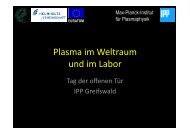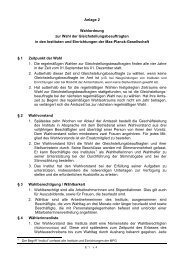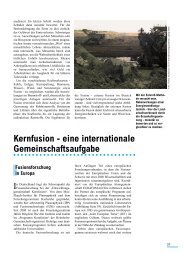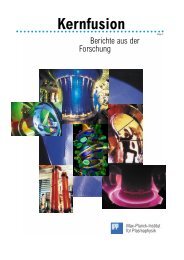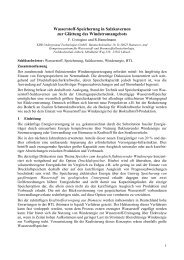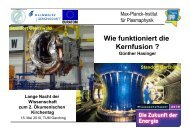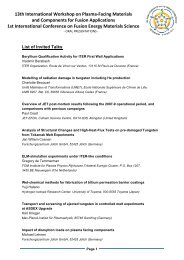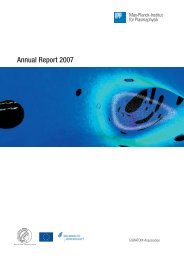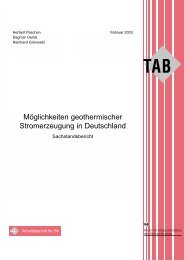Create successful ePaper yourself
Turn your PDF publications into a flip-book with our unique Google optimized e-Paper software.
A WALK<br />
ROUND THE OLD TOWN
The history of Rosenheim began<br />
with the Romans who built a bridge<br />
across the river Inn near their fort<br />
»Pons Aeni«. Name and coat of arms<br />
of the town come from the white rose<br />
of the arms of the Earls of Wasserburg<br />
who, in 1234, built a castle near<br />
Rosenheim. Salt trade and navigation<br />
on the river Inn were the sources<br />
of prosperity in the Middle Ages.<br />
In 1810 salt works were installed in<br />
Rosenheim.<br />
The salt water came from Bad<br />
Reichenhall via a wooden pipeline.<br />
The opening of the railway lines<br />
Munich–Innsbruck and Munich –<br />
Salzburg (1857–1860) was<br />
Rosenheim’s beginning as a<br />
commercial and cultural centre of<br />
south-east Bavaria with about 60,000<br />
inhabitants.
1<br />
SCULPTURE GARDEN<br />
SALINGARTEN<br />
The Salingarten in front of the Culture<br />
and Congress Centre has developed<br />
into a sculptur garden since 1987,<br />
showing pieces of art in various sizes<br />
by famous local sculptors.<br />
CHURCH HEILIG-GEIST<br />
The Hl. Geist church was founded by<br />
the citizen Hans Stier in 1449.<br />
After 1684 the Gothic church was<br />
decorated with Baroque elements.<br />
The tower – originally crowned with<br />
a Gothic top – got a Baroque onion.<br />
The picture Volto-Santo (a painting<br />
»al-secco« dating from the 15th<br />
century) up in the chapel St. Wolfgang<br />
is worth seeing.<br />
2
MAX-JOSEFS-PLATZ<br />
(SQUARE)<br />
Pedestrian Precinct<br />
Nowadays the Max-Josefs-Platz –<br />
in former times the Inner market and<br />
market place – is the »living room«<br />
of Rosenheim. Since 1984 the<br />
historical market square has been<br />
reserved for pedestrians.<br />
a) The Max-Josefs-Platz is surrounded<br />
by beautiful »Inn-Salzach« buildings.<br />
Typical for this architectural style are<br />
the archways (with pointed, round<br />
and flat arches), vaults inside the<br />
houses, bay-windows and saddle roofs<br />
behind high front walls.<br />
3<br />
b) The houses in Max-Josefs-Platz<br />
were built after the disastrous fire of<br />
1641 (they partly date back to the<br />
14th/ 15th century). Former narrow<br />
wooden buildings were put together<br />
to imposing two-storied stone houses.<br />
In the 19th century a third storey was<br />
added to many of the beautiful<br />
patrician houses and the decoration<br />
of the façades was altered.<br />
c) On the signboard of the inn<br />
»Stockhammer« you can see a<br />
historical convoy of boats.<br />
For centuries flat-bottomed wooden<br />
barges – mostly loaded with corn –<br />
were pulled up the river Inn by horses.<br />
3
3<br />
d) The patrician house »Zum Santa«<br />
– its Gothic core had already been<br />
altered in 1642 – was decorated with<br />
Rococo façade in 1745. In the<br />
restaurant the Gothic vaults are well<br />
preserved.<br />
The present façade is a mixture of<br />
the original rococo façade of 1745<br />
and a Neo-Rococo decoration of the<br />
19th century.<br />
e) From 1641–1878 house No. 22<br />
was the town hall of Rosenheim.<br />
A relief shows the house with a<br />
Baroque gable which was altered<br />
by a reconstruction after 1878.<br />
The corn sacks on the relief remind<br />
us of the busy trading in the<br />
market place.<br />
f) The house »Bergmeister« with its<br />
splendid corner windows was<br />
Rosenheim’s parsonage for a period<br />
of about 100 years.<br />
The Rococo door on Hl. Geist-Street<br />
in the Late Gothic arch are worth<br />
seeing.<br />
g) In front of the house »Bergmeister«<br />
there is a fountain with a Late Rococo<br />
statue of St. Nepomuk, one of the<br />
patron saints of the river-navigators.<br />
3
4<br />
MITTERTOR (GATE)<br />
Before 1350 the Mittertor (it is the<br />
only gate still in existence) was the<br />
east gate of Rosenheim. It was<br />
surrounded by two moats.<br />
From the 15th century it separated<br />
the Inner Market from the Outer<br />
Market and was the seat of the<br />
municipal administration. The onioncrowned<br />
tower was added after 1641,<br />
later the long building was altered.<br />
In its core the Mittertor is the oldest<br />
building in the town. Today it is home<br />
to the Municipal Museum<br />
with a unique collection beginning<br />
with the Romans up to Rosenheim’s<br />
history in the 20th century.<br />
On the façade pointing to Ludwigsplatz<br />
you can see on the left the coat<br />
of arms of Rosenheim – the white<br />
rose on red background – and on the<br />
right the coat of arms of Bavaria.<br />
LUDWIGSPLATZ<br />
(SQUARE)<br />
The Ludwigsplatz was part of the socalled<br />
Outer Market that developed<br />
in the 15. th century as a result of the<br />
growth of the town.<br />
5
CHURCH ST. JOSEPH<br />
The St. Joseph church was founded<br />
in 1618/1619 by the citizen Simon<br />
Peer. The church burned down in<br />
1641. It was rebuilt by Andreas Peer,<br />
the founder’s son. In the middle of<br />
the 18th century the original<br />
furnishings were replaced: it was<br />
equipped with a Baroque altar, a<br />
Rococo pulpit and pictures from the<br />
local painter Joseph Anton Höttinger<br />
showing the life of St. Joseph.<br />
6<br />
7<br />
PARISH CHURCH<br />
ST. NIKOLAUS<br />
The parish church St. Nikolaus was<br />
built in Late-Gothic style with a<br />
pointed Gothic tower around 1450.<br />
1641 fire damage.<br />
1642–1657 rebuilding of the church<br />
and the tower (with a Baroque onion)<br />
– nowadays the landmark of Rosenheim.<br />
The furnishings were changed<br />
several times according to the<br />
contemporary taste in Baroque and<br />
later in Neo-Gothic style.<br />
In 1880 the nave was lengthened<br />
by three bays in the direction of<br />
Ludwigsplatz. 1960 was the<br />
beginning of redesign works on the<br />
interior.<br />
The oldest work of art is the painting<br />
»Our Blessed Lady and Her Protective<br />
Cape« dating from 1514.
8<br />
TOWN HALL<br />
The town hall has an eventful history:<br />
After a construction time of three<br />
years the building was opened in<br />
1858.<br />
It was the first railway station in<br />
Rosenheim. At that time it was<br />
regarded as one of the prettiest<br />
station buildings in Bavaria. But as<br />
soon as 1878 the building was used<br />
for another purpose – it became<br />
Rosenheim’s town hall. Since then<br />
the building has been altered several<br />
times.<br />
MUNICIPAL GALLERY<br />
Founded in 1935 by the citizen Max<br />
Bram, it belongs to the finest galleries<br />
in Bavaria. Every year there are six<br />
art exhibitions ranging from modern<br />
art to ancient art plus a wide-ranging<br />
fringe programme (concerts, readings,<br />
guided tours, educational<br />
programmes). The focus is on<br />
exhibitions showing regional art.<br />
Open:<br />
Tuesday–Sunday<br />
10 a.m.–5 p.m.<br />
(Closed on Monday and holiday)<br />
9
10<br />
LOKSCHUPPEN<br />
From 1857–1878 the Lokschuppen<br />
was the engine round house next<br />
to the station.<br />
The building was renovated in 1988.<br />
Since that time it has developed<br />
into the most renowned exhibition<br />
centre in south-east Bavaria.<br />
Every year most attractive and<br />
exhaustive cultural as well as<br />
commercial exhibitions are held here.<br />
Open during exhibitions:<br />
Monday–Friday<br />
9 a.m.–6 p.m.<br />
Saturday, Sunday, holiday<br />
10 a.m.–6 p.m.<br />
KULTUR +<br />
KONGRESS ZENTRUM<br />
The Culture and Congress Centre has<br />
been built on the site of a former<br />
Capuchin monastery which existed<br />
from 1604–1803. This was closed<br />
during the secularization and the<br />
monastery buildings with the church<br />
were demolished.<br />
In 1810 salt works were erected on<br />
the spot and in operation up to 1958.<br />
The salt works to which the salt water<br />
was transported by means of a<br />
wooden pipeline about 110 km long<br />
was one of the foundations for the<br />
industrialisation of Rosenheim. In<br />
1967 the buildings were demolished<br />
to be replaced by the culture centre<br />
– one of the most important<br />
institutions for all kinds of events.<br />
It was opened in 1982.<br />
1997 it was enlarged by the congress<br />
centre.<br />
11
MUSEUMS – GALLERIES –<br />
EXHIBITIONS IN ROSENHEIM<br />
4b MUNICIPAL MUSEUM<br />
Ludwigsplatz 26, Rosenheim,<br />
Tel. 0 80 31/79 89 94<br />
It was established in 1894.<br />
Since 1902 it has housed in the<br />
Mittertor. About 5,000 objects<br />
of art history of the town and<br />
district are on display. It is one<br />
of the biggest non-state-owned<br />
museums of south-east Upper<br />
Bavaria. The activities of the<br />
museum centre on prehistory<br />
and ancient history, Roman<br />
period, navigation on the river<br />
Inn, history of Rosenheim<br />
and crafts.<br />
Open:<br />
Tuesday–Saturday<br />
10 a.m.–5 p.m.<br />
9<br />
MUNICIPAL GALLERY<br />
Max-Bram-Platz 2, Rosenheim,<br />
Tel. 0 80 31/36 14 47<br />
Every year there are six art<br />
exhibitions ranging from<br />
modern to ancient art.<br />
Open:<br />
Tuesday–Sunday<br />
10 a.m.–5 p.m.<br />
EXHIBITION CENTRE<br />
LOKSCHUPPEN<br />
ROSENHEIM<br />
See No. 10
MUSEUMS – GALLERIES –<br />
EXHIBITIONS IN ROSENHEIM<br />
12<br />
INN MUSEUM<br />
Innstraße 74, Rosenheim,<br />
Tel. 0 80 31/3 05 01<br />
It gives a good survey of the<br />
fluvial topography and river<br />
control. Many exhibits explain<br />
the navigation on the river Inn,<br />
one of the sources of wealth<br />
and prosperity of Rosenheim<br />
in the Middle Ages. Other<br />
points of interest are geology,<br />
bridge building, history of<br />
settlement, ship building and<br />
improvement of water routes.<br />
Open:<br />
Friday 9 a.m.–noon<br />
Saturday and Sunday<br />
10 a.m.–4 p.m.<br />
(Open only April–October)<br />
13<br />
WOOD ENGINEERING<br />
MUSEUM<br />
Max-Josefs-Platz 4,<br />
Rosenheim,<br />
Tel. 0 80 31/1 69 00<br />
It was opened in 1990 and<br />
explains the history of wood<br />
engineering. Centre of<br />
attention is the versatility of<br />
native timber in former times<br />
and today in the fields of home<br />
furnishing, traffic, agriculture,<br />
engineering, architecture and<br />
art. Not the final products are<br />
displayed but their production,<br />
necessary tools and skill of<br />
the craftsmen.<br />
Open:<br />
Tuesday–Saturday<br />
10 a.m.–5 p.m.
Luitpoldhalle<br />
Hallenbad<br />
Am Roßacker<br />
Heilig-<br />
Luitpoldstraße<br />
Prinzregentenstraße<br />
Bahnhofstraße<br />
Bahnhof<br />
Samerstraße<br />
Friedhof<br />
Geist- Straße<br />
Salinstraße<br />
Salingarten<br />
1 11<br />
Münchener Straße<br />
Anton-Kathrein-Str.<br />
Gießereistraße<br />
Herbststraße<br />
Gillitzerstraße<br />
P4<br />
Inntalhalle/<br />
Loretowiese<br />
Stollstraße<br />
Kufsteiner Str.<br />
Reifenstuelstraße<br />
POINTS OF INTEREST AND SIGHTS<br />
1<br />
2<br />
3<br />
Information<br />
Salingarten<br />
Church Heilig-Geist<br />
Max-Josefs-Platz<br />
4<br />
4b<br />
5<br />
6<br />
Mittertor<br />
Am Salzstadel<br />
Mittertor<br />
Kaiserstraße<br />
Rathausstraße<br />
Kufsteiner Straße<br />
Reichenbachstr.<br />
Polizei<br />
Ellmaierstraße<br />
Städt.<br />
4 + 4b Museum<br />
Rathaus<br />
Pettenkoferstr.<br />
Binderweg<br />
Innstraße<br />
Städt.<br />
Galerie<br />
Brianconstraße<br />
Krankenhaus<br />
Färberstraße<br />
13<br />
St. Joseph<br />
Holztechn.<br />
5<br />
2<br />
Ludwigsplatz<br />
7<br />
Hl.-Geist St. Nikolaus<br />
3<br />
Museum<br />
6<br />
P2<br />
Municipal Museum<br />
Ludwigsplatz<br />
Church St. Joseph<br />
Max-Josefs-Platz<br />
Brixstr.<br />
P1<br />
10<br />
7<br />
8<br />
9<br />
10<br />
Königstraße 9<br />
8<br />
zum 12<br />
Inn-Museum<br />
Rathausstraße<br />
Eisstadion<br />
Freibad<br />
Mangfall<br />
Parish Church St. Nikolaus<br />
<strong>Town</strong> Hall<br />
Municipal Gallery<br />
Lokschuppen<br />
11<br />
12<br />
13<br />
Kultur + Kongress Zentrum<br />
Inn-Museum<br />
Wood Engineering Museum
ACCESS<br />
Whether you come by car, by train or by<br />
plane: Rosenheim is easy to travel to.<br />
Travel by car:<br />
In the centre of the motorway<br />
connections<br />
Munich–Salzburg and<br />
Munich–Innsbruck<br />
Travel by train:<br />
IC-station Rosenheim<br />
Travel by plane:<br />
Airport Munich – 110 km<br />
Airport Salzburg – 70 km<br />
For more information please contact<br />
the Touristinfo Rosenheim, Ticketoffice,<br />
(Kultur + Kongress Zentrum)<br />
Kufsteiner Straße 4<br />
83022 Rosenheim<br />
Tel. 0 80 31/365-90 61<br />
Fax: 0 80 31/365-90 60<br />
Internet: www.touristinfo-ro.de<br />
email: touristinfo@rosenheim.de<br />
Herausgeber:<br />
Veranstaltungs +<br />
Kongress GmbH,<br />
Rosenheim<br />
GUIDED TOURS<br />
From May to October the Touristinfo<br />
offers guided tours through<br />
Rosenheim on Saturdays.<br />
Guided tours for groups are offered<br />
throughout the year.<br />
Booking address:<br />
Touristinfo Rosenheim.




